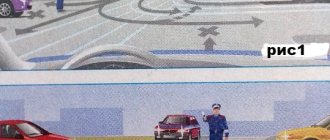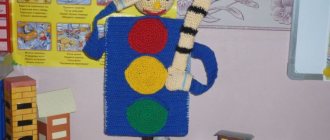Traffic rules quiz
- On the back of the bus/trolleybus there is an inscription: “Skid - 1 m” or “Danger when turning.” What is its significance?
(The above vehicles may lose control while turning, putting the lives of nearby passersby at risk.)
- What is the threat from bushes and trees planted along the edges of streets?
(They limit the view of the street and the movement of vehicles; a pedestrian may not notice a car that suddenly leaves from behind the plantings).
- How to move near the road if there is no sidewalk?
(If there is no sidewalk (for example, in the suburbs), you should move along the side of the road, on the left side, so that traffic moving in the oncoming lane is clearly visible).
- Why should you be wary of vehicles with trailers?
(Because when a car turns, the trailer can skid, hitting one of the pedestrians; an absent-minded passerby, deciding that the car has already passed, will begin to cross the highway and fall under the trailer).
- What is the braking distance of a car if the driver reacts instantly?
(Depends on the current speed, on average - 10-20 m).
- Why does a pedestrian need to be vigilant when cars moving towards each other are nearby?
(A car moving on one side passes another car, and at this moment the driver and the passer-by do not notice each other).
Rules
- Where is it unsafe to cross the road - at a street intersection or near a bus stop?
(Both of these areas are potentially risky to cross. However, stopping is considered more unpredictable, especially for children.
- After getting off the bus, the child hurries to cross the road as quickly as possible, going around it in front or behind. At the same time, it does not focus on a car driving around a bus or moving in the oncoming lane.
- Trying not to be late for a bus that has arrived at a stop on the opposite side, the child will not notice the car on the road, which can lead to an accident.
- In unfavorable weather conditions, a braking bus may lose control and hit passers-by at the stop.
- When passengers enter and exit the bus, there is a chance that the one who hesitates will be crushed by the closing door).
- Can a car driver see a pedestrian every time he approaches him?
( No. The driver must not lose sight of both passers-by on the sidewalks and at pedestrian crossings, as well as other drivers. It is extremely unsafe for a pedestrian to cross the road at dusk - if caught in the headlights of 2 cars moving towards him, it is almost impossible to see him.
- What factors cause the greatest difficulties for driving and crossing roads in the city?
(There are several such factors:
- It is quite difficult to see a small passenger car or moped in advance, since the roadway is “full” of trucks, buses, etc. When stopping or moving, they hide small transport objects.
- The roadway of the street is sometimes planted on the sides with trees and shrubs; nearby there are fences, billboards, buildings built close to the road - all this reduces the view of the street).
- The greatest dangers lie near the roadway.
(A car moving at high speed is unsafe, but passenger cars or larger transport objects that are not moving pose no less of a threat: a stationary car can obscure another car that is in motion and inaccessible to the pedestrian’s view; without paying attention to it , the passer-by believes that there is no threat and crosses the road, falling under the wheels of a car).
For children
- a Zebra sign give any privileges to a passer-by to cross the roadway?
(No, this sign only indicates to the passer-by a place where it is not prohibited to cross the roadway. On a zebra crossing, where there is no traffic control, passers-by are allowed to enter the roadway only after first assessing how far it is to the approaching vehicle , how fast it is going and making sure that it is safe to cross the street).
Do children need traffic rules?
According to WHO, more than 2 thousand children are injured or killed on the roads every day. This is largely due to ignorance of the rules of behavior on the street. Therefore, there is only one answer - knowledge of traffic rules is simply necessary for children, and the task of adults is to teach them both in the family and at school the “ABC of the Road”.
Primary school students must learn rules containing the following provisions:
- you should cross the road using special markings, following the traffic lights,
- cycling is carried out in accordance with the requirements,
- travel by category B vehicle is organized by adults,
- You should know the meaning of common road signs.
You can practice skills using game methods. Dramatizations, riddles, puzzles, crosswords, and Olympiads will come in handy. The traffic rules quiz will be very interesting for children of all ages.
Blitz questionnaire on traffic rules
- A vehicle on four wheels that can move independently. (Car).
- The name of horse-drawn transport used in ancient times. (Coach).
- How can you transport more passengers than a car? (By bus).
- A favorite vehicle for active boys, they ride it by pushing off with their feet. (Scooter).
- A car that can move even on the worst roads. (SUV).
- "House" for the car. (Garage).
- A place where planes stay between flights. (Hangar).
- Passerby walking along the sidewalk. (A pedestrian).
- The name of the alley in the middle of the street. (Boulevard).
- Where do the trams go? (On the rails).
For children - A road section intended for pedestrian movement. (Sidewalk).
- Who is driving the car? (Driver).
- Who flies the plane? (Pilot, pilot).
- What can you use to stop a car? (Brakes).
- The name of the striped markings for pedestrians. (Zebra).
- Where do the streets intersect? (At the crossroads).
- What do special vehicles use to honk loudly: ambulance, fire, police? (With the help of a siren).
- A place where pedestrians become passengers on public transport or disembark from it. (Stop).
- Reliable wide fabric stripes that can reduce the danger for the driver and passengers in a passenger car. (Seat belts) .
- What does a motorcyclist wear on his head to protect it from injury? (Helmet) .
- What do you call a passenger who likes to travel without a ticket? (Hare).
- A single name for large vehicles of various types that transport a large number of citizens. (Public transport).
- What do you call someone who rides in a vehicle but is not behind the wheel? (Passenger).
- Ticket seller in public transport. (Conductor).
- Public transport running underground. (Metropolitan).
- Mobile staircase in the underground. (Escalator).
- Where is the driver of a car, bus, trolleybus, tram. (In the cockpit).
- A sports facility where circuit cycling races are held. (Cycle track).
- What is the name of the area where the railway tracks intersect with the highway? (Moving).
- The name of the crossbar that opens and closes the railway crossing. (Barrier).
- What do the rails rest on? (On the sleepers).
- A road outside the city, covered with asphalt, along which vehicles move. (Highway).
- A ditch for drainage of water located along the road. (Ditch).
- What does a car use to move? (Using wheels).
- How does a driver see the road in the dark? (Turns on headlights).
- The name of the part of the truck in which goods are transported. (Body).
- A truck whose body can dump its own cargo. (Dump truck).
- The motor is hidden under this cover. (Hood).
For children - How can you tow a car? (Using a cable).
- The name of the underground structure through which vehicles move. (Tunnel).
- The name of the car coincides with the name of a large river in Russia. (Volga).
- What do you call a pedestrian or driver who does not follow traffic rules? (Violators).
- How are traffic violators punished? (They charge a fine).
Quiz script for elementary school
Participants: students in first to fourth grades. First and second graders only need to complete half of the assignments.
Important! There is only one correct answer.
Warm-up for participants
The presenter, having named the theme of the event, offers riddles to the participants:
- The three-eyed giant stands near the side of the road, examines the road, suggesting actions to pedestrians and drivers. (Traffic light)
- Not a horse, not a goat, not a lioness, lying down, the algorithm for crossing the route is suggested by drawn stripes. (Zebra)
- Two wheels, steering wheel, crossbar. What is this? (Bike)
- Convenient, small, available inside the car. It is impossible for an adult to use a hidden object. (Baby car seat)
- The descent of the stairs will allow you to safely reach the opposite side of the highway. (Underground crossing)
Each block of questions is asked by a character dressed in a fairy tale costume: Traffic Light, Znayka, Dunno. The literary hero and the presenter spend the last part together, verbally assessing the children’s answers.
The first part of the game: the name "WHERE"
1 question. Features of crossing the road in the evening: 1) there are no differences; 2) clothing must be equipped with reflective stickers; 3) quickly.
Question 2. What prevents pedestrians from fully seeing the highway? 1) wearing a hood, dark glasses, a hat that hides the eyes; 2) there are no reasons for danger; 3) backpack, briefcase, satchel.
Question 3. Do you need to inspect the road before crossing? 1) no, unnecessary; 2) mandatory; 3) the vehicle will have time to stop, the driver will see the pedestrian.
Question 4. A younger brother crosses the road with a primary school student, do you need to hold his hand? 1) no; 2) must be held tightly; 3) let him hold the elder’s hand.
Question 5. There is no traffic light, how to cross the highway? 1) using a pedestrian crossing; 2) in the absence of vehicles; 3) taking into account convenience.
Question 6. How to cross the road in the rain? 1) similar to the transition in dry weather; 2) be especially careful: there is a risk of slipping while passing through the roadway; 3) using an umbrella.
Right answers:
{1-2; 2-1; 3-2; 4-2; 5-1; 6-2}
The second part of the game: the name "Driver"
1 question. Is an elementary school student cyclist allowed to ride on the roadway? 1) strictly prohibited; 2) strictly in the presence of adults; 3) has the right.
Question 2. Where can children ride bicycles? 1) sidewalk; 2) highway; 3) only at home.
Question 3. What does the “No Cyclists” sign represent? 1) person, specified vehicle; 2) bicycle; 3) two motorcycles.
Question 4. What does the road sign “Path for pedestrians and cyclists” show? 1) adult, vehicle; 2) people; 3) adult, child, bicycle.
Question 5. How to use a dedicated bike rack? 1) park the equipment near the designated space; 2) carefully park the bike; 3) ignore.
Question 6. Is it legal to carry large loads with a bicycle? 1) prohibited, the trunk is intended for the transportation of light weight cargo; 2) certainly meets the requirements; 3) sometimes.
Right answers:
{1-1; 2-1; 3-2; 4-3; 5-2; 6-1}
The third part of the game: the name "Car"
1 question. Does a child have the right to drive? 1) no; 2) yes, when driving on a country road; 3) yes, it’s so interesting to steer.
Question 2. Can the student drive the car themselves? 1) impossible due to age, lack of a driver’s license; 2) allowed at a short distance; 3) yes.
Question 3. Where should a child sit in a car? 1) car seat; 2) left, right of the driver; 3) back seat, left side.
Question 4. How many passengers can travel in one regular car: 1) five; 2) nine people; 3) eight.
Question 5. What are mirrors used on the outside of a car? 1) see what is happening on the left, right, behind; 2) check the neatness of the hairstyle; 3) compliance with technical specifications.
Question 6. What does the road sign “Railway crossing with barrier” contain? 1 person; 2) car; 3) sleepers, rails.
Question 7 What is shown on the road sign “Railway crossing without barriers”? 1) train; 2) rectangle; 3) conductor.
Right answers:
{1-1; 2-1; 3-1; 4-1; 5-1; 6-3; 7-1}
Quiz results
When summing up, you should pay attention to how important it is to know the traffic rules. It must be emphasized: a responsible pedestrian learns the rules, understanding that human life depends on them. The traffic knowledge game involves conducting a kind of reflection: checking what children remember from the basic rules governing traffic, and whether they are satisfied with their answers.
Attention! The presenter will pronounce a sentence, omitting one or two words; the children need to add the missing information.
Examples of tasks:
- Before starting the transition, stop to... (look around).
- Don't run across ... (road).
- Cross the road at ... (pedestrian crossing).
- The three-eyed one will tell you how to cross the road correctly... (traffic light).
- Children should not ride on the road on ... (bicycle).
- Take off your head... (hood) when crossing the road.
- Sunglasses... (glasses) prevent a pedestrian from objectively assessing the situation when crossing to the opposite side.
Parents! It should be remembered that it largely depends on adults how prepared our children will be for correct behavior on the road. Be a role model!




